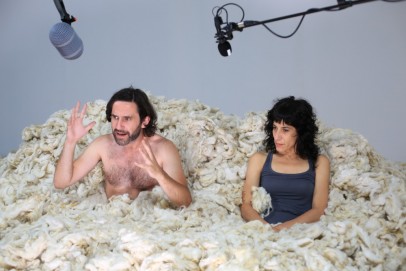
From the bustling streets and rowdy patrons of Temple Bar, an inquisitive audience is greeted with piles upon piles of hand-spun wool in a minimalist space. This is Breaking Rainbows, a fusion of abstract and traditional theatre written and directed by visual artist Orla Barry.
Besides the stark contrast of the natural with the artificial nature of the building, screens are placed nearby with a series of words printed on them, deconstructed meticulously in varying sizes, hinting at the controlled maelstrom of language to come. While the main element drawing the eye is still the mountains of wool, creating a personal and intimate atmosphere before anyone has even taken to the stage, the screens feel imposing and loom over this primal connection to a distant place and time.
The actors enter unceremoniously and construct seats for themselves by stacking wool while simultaneously introducing the first scene. The rough story of this work is based around the relationship between a shepherd, played by Einat Tuchman, and a ram, played by Derrick Devine. The tale is told through a series of vignettes. Barry’s deep connection with her livestock shines through immediately, and there is a certain informality to how this first scene unfolds that hearkens back to a simpler time of storytelling, rooted in expression and emotion rather than complex visuals and choreography.
There are several dimensions to the theme of nature in our modern world which keep the piece interesting. The first questions the idea of the feminine in a traditionally masculine trade. This idea of power is later explored in relation to the animals featured, awarding them a human voice to express their emotions. Despite this investigation, both the women and the animals remain united as “others” in this male-dominated sphere. The examination of these elements is, however, humorously colloquial, making it feel less like a heavy burden on the mind and more like an invitation to question. The passion which arises from the seemingly quaint occupation of shepherding gives life to otherwise small, unassuming moments in the tales of this worker. The suggestion seems to be that there are more opportunities for a rush of adrenaline through this simplistic way of life. This is achieved through disregarding the notion of the calm, pastoral image which enters the minds of many when one thinks of the life of a shepherd.
While the first scene is set to introduce the audience to this world, the rest are picked at random by the audience from a box with sheets of paper giving the titles of scenes. This can be seen to provide an invaluable contribution to the energy and creativity of Devine and Tuchman. From this point on, theatrical structure is abandoned as the actors instead break into song to personify the sun and rain’s ongoing competition for supremacy.
Later, an abstract phrase is repeated over and over by both the shepherd and the ram for minutes on end with variations in pitch, speed and tone highlighting the meaningless nature of words when taken to their illogical conclusion. The body language exhibited and voice used tell a story in which a coherent series of words is not required.
A later scene shows the shepherd jogging in circles while reciting her morning routine in meticulous detail. The apparent ludicrousness of the performance does occasionally make the actors break for a moment to laugh along with the audience. Although this may seem unprofessional to some, it can also be understood as a natural contribution to that close, personal bond previously formed between audience and actors. Similarly, the boisterous and spontaneous relationship between the shepherd and the ram is presented as real and unfiltered despite the abstract tone of many of the scenes.
The final scene chosen by the audience presented an affecting call to arms to stop ignoring the problem of global warming and to proactively care for the natural world. The facts and information associated with the scientific argument are left to the side, to instead bring emotions into the fold. This powerful ending to the somewhat-chaotic experience of the play ensured that the audience were left with a greater appreciation for their own role in the production, as the masters of the running order. If this emotional moment had been presented at the beginning of the production, it may not have been quite so poignant. Breaking Rainbows is certainly not for everyone, but if you’re receptive to the unexpected and the strange there will definitely be something here to engage you.
A free video installation of the performance will be open to the public in the Temple Bar Gallery from October 6th to November 5th.






